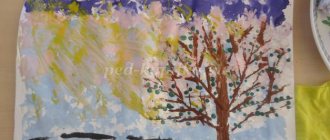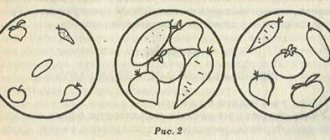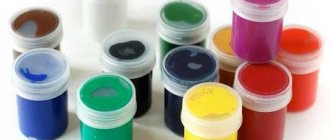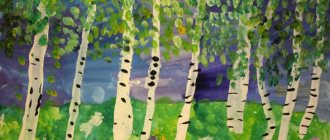Article GCD ON DRAWING MIDDLE GROUP Topic: My home. Author: BASHKIROVA TATYANA ALEKSEEVNA
Author: BASHKIROVA TATYANA ALEKSEEVNA NODE IN DRAWING MIDDLE GROUP
Topic: My home
Program content:
- to instill in children humane feelings towards their loved ones, their home
- form ethical ideas.
Equipment and materials:
- demonstration material with images of a hollow, anthill, birdhouse, albums, pencils, felt-tip pens.
Preliminary work:
- reading the fairy tale “Teremok”.
Author: BASHKIROVA TATYANA ALEKSEEVNA NODE IN DRAWING MIDDLE GROUP Topic: My home Program content: - to instill in children humane feelings towards their loved ones, their home - to form ethical ideas. Equipment and materials: - demonstration material with images of a hollow, anthill, birdhouse, albums, pencils, felt-tip pens. Preliminary work: - reading the fairy tale Teremok. Progress of the lesson: The teacher asks the children riddles and shows them pictures of the answers. In the trunk, in a large tree, there is an excellent squirrel's house. It's cozy and warm. What kind of house is that? - (hollow) What kind of miracle is this house? We cannot count the floors and windows in it, but ants live here. (Anthill) Educator. -Children, what are these riddles about? About the dwellings of animals. Every bird, squirrel, and ant has its own house. Remember the fairy tales about animals whose home was taken away. -Where do you live? Let's play the game Who Lives Where. Children stand in a circle and pass each other a ball with the words I live on... floor. — Guys, tell us why you love your home. (Children's answers.) Educator. -Guys, which of you have pets? Tell us what they are like and why you love them? -The teacher helps the children with leading questions: -What is your friend’s name? -What does he like to eat? -What are you playing with him? -Why do you love him? Educator. -Children, why do you think a person needs a house? — Each of us needs a home. A home is a place where a person is loved, waited for, and taken care of. Listen to Russian folk proverbs about home. -Being a guest is good, but being at home is better. - To lead a house, don’t weave bast shoes. - Without an owner, the house is an orphan. -At home, not as a guest: once you sit, you won’t leave. -Every house is held by its owner. The teacher reads a poem to the children by N. Gol: My house Look: this is a house - With a roof, a door and a window, And with a porch, and with a chimney, The color of the house is blue. Feel free to come into the house! - Do you invite me? Let's come in! Educator. -There are a lot of houses in our city, they are all different. Draw your house, think about its roof, walls, and windows. Summary of the lesson. The teacher organizes a general exhibition of children's works. Everyone looks at the drawings together and chooses the best ones. The teacher helps the children conclude that all the houses are very beautiful. HYPER13PAGE HYPER15 2 comments powered by HyperComments
Summary of a lesson in visual arts on the topic: “The house where I live”
Summary of a lesson in visual arts on the topic: “The house in which I live.” Preparatory group
Goal: To develop a sense of patriotism in preschoolers by understanding such concepts as native nature, hometown Vyazemsky,
Objectives: To teach children to convey in drawing the shape of buildings and parts of a house, the variety of structures of city houses: multi-story narrow, low and wide. To cultivate patriotic feelings, interest in learning about one’s native city and its history. Instill love for your small Motherland. Promote aesthetic education. Practice drawing with crayons, pencils and felt-tip pens. Preliminary work. Working with parents, designing the photo exhibition “The House I Live In,” introducing children to the sights of the city of Vyazemsky. Materials: Colored crayons, pencils, paper, photographs of city streets in the city of Vyazemsky Progress of the lesson. Vos-l: “Do you hear the song of the stream - this is your homeland! You hear the nightingale’s voice - this is your homeland! Kindergarten where your friends are - this is your homeland! Your mother's hands, the sound of branches and the sound of rain. And the currants in the garden are also the Motherland!” In Russia, like in any other country, there is a main city - the capital. Guys, name the capital of our country (children's answers). Voss. :Fine! In what city is your home or kindergarten located? (children's answers) Voss: Well done! Yes, our city is called Vyazemsky, and we are residents of this city and they call us Vyazemtsy (children repeat). Vos: Our city is large and very beautiful (shows photos of city streets), our streets are different and beautiful in their own way, there are pharmacies, schools and kindergartens, shops on the streets. What attractions do we have? (children's answers: museum, city park, monuments, etc. the teacher shows a photo). Well done guys, tell me, do you know the name of the street where you live? (children's answers).Very good. That's how much interesting you know about our city. Voss: Now let’s do some physical exercise. One two three four five. (Children jump on the spot) Let's build and play. We are building a big, tall house. (They stand on their toes and stretch their arms up) We install windows and build a roof. (Show the window, the roof with your hands - clasp your hands above your head) What a beautiful house! (They extend their arms forward with an index gesture) An old gnome will live in it. (Squat) Voss: Guess my riddle and find out what we will draw today. Here is a huge noisy world. There are four hundred apartments in it. Five entrances, intercoms, glazed balconies (house) Vos: That's right, today you will draw the house in which you live. What shape are they? (children's answers). Houses can be tall and narrow, low and wide (the teacher shows illustrations). What elements does the house consist of? (children's answers). That's right, well done. Now you will draw the house in which you live. Then we will put together a street of our city from your drawings. Children draw on their own. The teacher helps those who find it difficult. The finished drawings are arranged in the form of a street. Vos: Guys, I invite you to look at your drawings, you did your best and your street turned out very beautiful.
Get text
Drawing in the middle group “The house you live in” (photo report)
Irina Chirkova
Drawing in the middle group “The house you live in” (photo report)
Drawing on the topic : “The house where you live .”
April 1, 2016
1. Teach children to draw a big house , convey the rectangular shape of the walls, rows of windows.
2. develop the ability of preschoolers to complement the image based on impressions of the life around them.
3. Nurture aesthetic feelings.
Preliminary work. Observations on walks with a teacher and parents. Reading and looking at illustrations.
Material: watercolor paints, album sheet.
Remember with your children what kind of houses they live in. Clarify their proportions, location of floors, doors. Offer to draw a street from different houses, on one sheet prepared by the teacher. Children take turns drawing the walls of the house, windows, doors and additional elements. Next, each child begins to draw his own house . For those who quickly draw a house, suggest drawing something additional: grass, trees, benches, the sun.
This is such an exhibition of works we have!
Collective hand painting in the middle group (photo report) We all know that creativity plays a huge role in a child’s life. But how to present this to a little person so that his development will occur.
Summary of a comprehensive lesson for the middle group “Drawing by design. Drawing a favorite toy" Summary of a comprehensive lesson for the middle group "Drawing a favorite toy" (drawing according to plan) Objectives: to introduce children to the names.
Summary of an integrated lesson on familiarization with the outside world in the preparatory group “How are you doing, frog?” Summary of an open integrated lesson on familiarization with the outside world in the preparatory group “How do you live, a frog?” Software.








